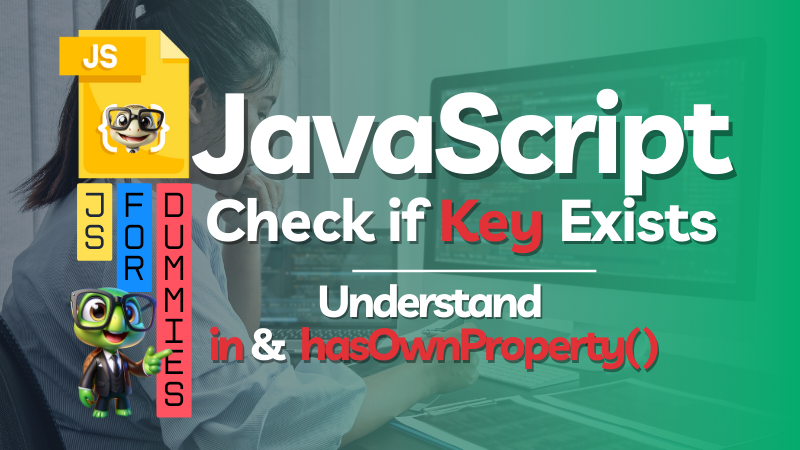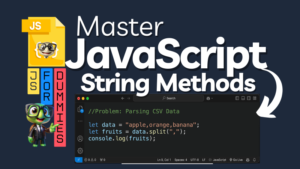
Of course! Here is a comprehensive, in-depth blog post on checking for keys in JavaScript objects, expanded to over 2000 words with detailed explanations, real-world analogies, and practical examples.
Meta Description: Master JavaScript key checking! Our definitive guide explains how to check if a key exists in objects & arrays using in, hasOwnProperty(), and more. Avoid common pitfalls with real-world examples. Essential reading for JS developers!
JavaScript for Dummies: Checking If a JavaScript Key Exists in Objects
Hey there! Let’s talk about one of those JavaScript topics that seems simple on the surface but has a surprising amount of depth: checking if a key exists in an object or array. If you’ve ever written code like if (obj[key]) and then spent an hour debugging why it failed when the value was false or 0, you’ve come to the right place.
You’re not a dummy for finding this confusing. In fact, this is a rite of passage for every JavaScript developer. The language provides several ways to check for keys, each with its own subtle behavior. Using the wrong one is like using a screwdriver to hammer a nail—it might work sometimes, but it’s going to lead to a messy situation eventually.
In this guide, we’re going to move beyond simple examples and dive into the why behind each method. We’ll use clear analogies, real-world scenarios, and explore the edge cases that trip up even experienced developers. By the end, you won’t just know how to check for a key; you’ll know which method to choose and why, making your code more robust, predictable, and professional.
Why Key Checking is Absolutely Critical
Let’s start with the fundamental question: why do we need to bother with all these different methods? Can’t we just access the key and see what we get?
The short answer is no, and here’s why. Failing to check for keys properly is one of the most common sources of bugs in JavaScript applications. It’s like assuming every house you walk into has a specific piece of furniture. You might be fine nine times, but on the tenth, you’ll walk straight into a wall.
Concrete consequences of poor key checking include:
TypeError: Cannot read properties of undefined: This is the classic JavaScript error. It happens when you try to access a property of a nested object that doesn’t exist. For example,user.address.citywill throw this error ifuser.addressisundefined.- Silent Logic Failures: Your code might run without crashing, but it produces incorrect results. For instance, if you check for a user’s membership status with
if (user.isPremium)andisPremiumisfalsefor a valid non-premium user, your code will treat them the same as a user who doesn’t have the key at all. - Data Corruption: In scenarios where you’re processing data from an external API or user input, assuming the presence of keys can lead to saving incorrect or malformed data to your database.
Real-World Scenario: User Profile Dashboard
Imagine you’re building a user profile page. Some users have provided their Twitter handle, while others haven’t. A poorly checked piece of code might try to render a link to https://twitter.com/@${user.socials.twitter}. If the twitter key doesn’t exist inside user.socials, you’ll either get a broken link to https://twitter.com/@undefined or a full-blown application crash. Proper key checking allows you to gracefully handle this by showing a default message or hiding the section entirely.
Understanding Your Data: JavaScript Objects and Arrays
Before we inspect the tools, let’s be sure we understand the materials we’re working with. While arrays are technically a type of object in JavaScript, we interact with them differently.
Objects: The Unordered Collection (Mostly)
const user = {
name: "Alice",
age: 25,
"favorite-color": "blue", // Note: keys with hyphens or spaces need quotes.
address: {
street: "123 Main St",
city: "Techville"
}
};Objects store data in key-value pairs. The keys are strings (or Symbols), and the values can be anything. When we check for a key in an object, we’re checking for the existence of that specific string (or Symbol) as a property name.
Arrays: The Ordered List with Numerical Indices
const scores = [95, 82, 78, 64];
const mixedArray = [10, "hello", { id: 1 }, null];Arrays are objects where the primary, intended keys are numerical indices (0, 1, 2, 3). However, because they are objects, you can assign other string keys to them, but this is generally considered a bad practice and can lead to confusing behavior.
const arr = [10, 20, 30];
arr.customProperty = "I'm here!";
console.log("customProperty" in arr); // true
console.log(1 in arr); // true
console.log(3 in arr); // false (no element at index 3)Understanding this dual nature of arrays is key to checking for indices correctly.
The in Operator: The Comprehensive Detective
Think of the in operator as a thorough detective who searches not only the suspect’s immediate possessions but also their house, car, and any storage units they might have access to.
Syntax:
"key" in objectHow it works: The in operator returns true if the specified key exists anywhere in the object’s own properties or its prototype chain (the objects it inherited from).
Example 1: Basic Usage with Ambiguous Values
const obj = {
name: "Alice",
age: undefined,
isActive: false,
score: 0
};
console.log("name" in obj); // true - Key exists with a truthy value.
console.log("age" in obj); // true - Key exists, even though the value is undefined!
console.log("isActive" in obj); // true - Key exists, even though the value is false!
console.log("score" in obj); // true - Key exists, even though the value is 0!
console.log("salary" in obj); // false - Key genuinely does not exist.This is the superpower of in. It completely ignores the value and only cares about the existence of the key itself.
Example 2: Arrays and Indices
const arr = [10, 20, 30];
// Let's create a sparse array (an array with a "hole")
arr[5] = 60;
console.log(0 in arr); // true - Index 0 exists.
console.log(1 in arr); // true - Index 1 exists.
console.log(4 in arr); // false - Index 4 is part of the "hole," it was never set.
console.log(5 in arr); // true - Index 5 exists.This makes in very useful for checking if a specific index exists in a sparse array, where arr.length would be misleading.
Example 3: Inherited Properties – The “Family Heirloom”
This is where in shows its comprehensive nature. All objects in JavaScript can inherit properties from a prototype.
// Every object inherits from the base 'Object.prototype'
const simpleObject = {};
console.log("toString" in simpleObject); // true
// Wait, we never defined 'toString'! It's inherited.
// A more explicit example:
const parentObj = { familyName: "Smith" };
const childObj = Object.create(parentObj); // Create an object that inherits from parentObj
childObj.firstName = "John";
console.log("firstName" in childObj); // true - It's his own property.
console.log("familyName" in childObj); // true - He inherited it!When to use in:
- When you need a definitive check for the presence of a key, regardless of its value.
- When you are working with sparse arrays and need to know if an index has been set.
- When you deliberately want to include inherited properties in your check (less common).
The hasOwnProperty() Method: The Strict Inspector
If the in operator is the comprehensive detective, hasOwnProperty() is the strict border control agent. They only care about what’s on your person right now, not what your family owns.
Syntax:
object.hasOwnProperty("key")How it works: This method returns true only if the specified key is a direct property of the object—not inherited from its prototype chain.
Example 1: Basic Usage (The Same, Until…)
const obj = { name: "Alice", age: undefined };
console.log(obj.hasOwnProperty("name")); // true
console.log(obj.hasOwnProperty("age")); // true - Still distinguishes key from value.
console.log(obj.hasOwnProperty("salary")); // falseSo far, it behaves the same as in for the object’s own properties.
Example 2: Ignoring the Inheritance
This is where the critical difference lies.
const parentObj = { familyName: "Smith" };
const childObj = Object.create(parentObj);
childObj.firstName = "John";
console.log("firstName" in childObj); // true
console.log(childObj.hasOwnProperty("firstName")); // true - It's his own.
console.log("familyName" in childObj); // true
console.log(childObj.hasOwnProperty("familyName")); // FALSE! - It's inherited, not his own.Example 3: Nested Object Exploration
A common task is checking for keys in nested objects. hasOwnProperty() is your first step.
const user = {
id: 1,
profile: {
name: "Alice",
email: "alice@example.com"
}
};
// Check if the 'profile' key exists on the user object.
if (user.hasOwnProperty("profile")) {
// Now it's safe to check inside profile.
if (user.profile.hasOwnProperty("email")) {
console.log(`Sending email to ${user.profile.email}`);
} else {
console.log("User profile is missing an email.");
}
} else {
console.log("User has no profile setup.");
}This pattern of checking at each level prevents the dreaded Cannot read properties of undefined error.
Direct Access and Its Dangerous Limitations
This is the most intuitive but also the most error-prone method. It’s like trying to find out if someone is home by yelling their name and, if you don’t hear a response, assuming the house doesn’t exist.
The Core Problem: Ambiguity with undefined
const config = {
theme: "dark",
refreshRate: undefined, // The user hasn't set a preference yet.
// The 'apiKey' is completely missing.
};
console.log(config.theme); // "dark" - Clearly exists.
console.log(config.refreshRate); // undefined - But does the key exist?
console.log(config.apiKey); // undefined - But does the key exist?
// The flawed check:
if (config.refreshRate !== undefined) {
// This block won't run, even though the key *does* exist.
console.log("Refresh rate is set.");
}
if (config.apiKey !== undefined) {
// This block also won't run, but for the correct reason.
console.log("API Key is set.");
}As you can see, using direct access and a comparison to undefined fails to distinguish between a key that exists with the value undefined and a key that is entirely absent. This is a critical distinction in many applications.
Common Mistakes and How to Avoid Them
Let’s codify these pitfalls into clear mistakes and their solutions.
Mistake 1: Using Direct Access for Existence Checks
The Flawed Code:
if (obj.key !== undefined) {
// Do something with obj.key
}This will fail silently if obj.key is explicitly set to undefined.
The Solution:
Use in or hasOwnProperty() for existence checks. Reserve direct access for when you are ready to use the value, after you’ve confirmed the key’s existence.
// Correct Approach
if ("key" in obj) {
// Now it's safe to use obj.key, even if it's undefined, false, or 0.
console.log("The key exists, its value is:", obj.key);
}
// Or, if you only care about own properties:
if (obj.hasOwnProperty("key")) {
// ...
}Mistake 2: Ignoring the Prototype Chain with in
The Flawed Assumption:
Assuming "key" in obj means the key is defined directly on obj.
The Solution:
If you need to be sure the property is not inherited, use hasOwnProperty().
// Checking for a method that might be inherited vs. overridden.
const myArray = [1, 2, 3];
console.log("toString" in myArray); // true - inherited
console.log(myArray.hasOwnProperty("toString")); // false
// If you've overridden it:
myArray.toString = function() { return "Custom"; };
console.log(myArray.hasOwnProperty("toString")); // true - now it's its own!Mistake 3: Calling hasOwnProperty on a Null or Undefined Object
This is a classic runtime error.
const someObject = maybeGetObject(); // What if this returns null?
// This will throw: Uncaught TypeError: Cannot read properties of null (reading 'hasOwnProperty')
if (someObject.hasOwnProperty("key")) {
// ...
}The Solution:
Use a safety check first. A modern and safe way is to use Object.prototype.hasOwnProperty.call().
// Safe way:
if (someObject && someObject.hasOwnProperty("key")) { ... }
// Even safer, works even if someObject is null/undefined:
if (Object.prototype.hasOwnProperty.call(someObject, "key")) {
// ...
}Best Practices for Bulletproof Key Checking
After all this, let’s distill everything into a set of actionable best practices.
- Default to
hasOwnProperty(): For most everyday use cases, you want to check for the object’s own properties. This is the safest and most intentional check. Use the safe call pattern (Object.prototype.hasOwnProperty.call) if you are unsure about the object’s existence. - Use
infor Inclusive or Value-Agnostic Checks: When you need to include inherited properties or when you specifically need to know if a key exists regardless of its value (like afalseorundefinedflag),inis your tool. - Never Use Direct Access for Existence Checks: Avoid
if (obj.key)orif (obj.key !== undefined)to determine if a key exists. These are value checks, not existence checks. - For Modern Code, Consider
Object.hasOwn(): A new, static methodObject.hasOwn(obj, key)is now a standard part of JavaScript. It’s intended as a more robust replacement forobj.hasOwnProperty(key), as it works even if the object has a null prototype or has overridden thehasOwnPropertymethod.const obj = { key: "value" }; console.log(Object.hasOwn(obj, "key")); // true console.log(Object.hasOwn(obj, "toString")); // false - Check at Each Level of Nesting: When dealing with nested objects like
user.settings.theme.color, always check each level before proceeding to the next to avoidTypeErrors.
FAQs
Q1: What’s the most reliable way to check if a key exists in an object?
For checking an object’s own properties, Object.hasOwn() (modern) or obj.hasOwnProperty() (classic, with safety checks) is the most reliable. For a check that includes inherited properties, use the in operator.
Q2: How do I check for a key in a nested object?
You must check at each level.
if (user && Object.hasOwn(user, 'settings') && Object.hasOwn(user.settings, 'theme')) {
// Now it's safe to access user.settings.theme
}Alternatively, use optional chaining (?.) for a more concise, though slightly different, approach: if (user?.settings?.theme) { ... }. This checks for existence and truthiness.
Q3: Can I use these methods for arrays?
Yes, but remember that for arrays, you are typically checking for numerical indices. in and hasOwnProperty work for this. You can also check if an index is within the bounds of a non-sparse array with index < array.length.
Q4: What’s the difference between in and hasOwnProperty()?
The in operator checks the entire prototype chain (inherited properties), while hasOwnProperty() only checks the object’s own properties.
Q5: What if my object has a hasOwnProperty key?
This is a rare but potential pitfall. If an object has its own property called 'hasOwnProperty', calling obj.hasOwnProperty('key') will fail because you’ve overridden the method.
const obj = { hasOwnProperty: "I'm a string!" };
console.log(obj.hasOwnProperty("key")); // TypeError: obj.hasOwnProperty is not a functionThis is why using Object.prototype.hasOwnProperty.call(obj, "key") or the new Object.hasOwn(obj, "key") is safer.
Q6: How does optional chaining (?.) fit into all this?
Optional chaining is a fantastic modern feature for safe property access, but it’s not a direct replacement for key existence checks. obj?.key prevents crashes if obj is nullish, but it still returns undefined if the key doesn’t exist. It’s best for safely traversing structures where you want to access a value, not for performing a boolean check on a key’s existence.
Conclusion
Checking for a key in a JavaScript object is a fundamental skill, but as we’ve seen, it’s far from a one-size-fits-all operation. The journey from confused beginner to confident developer involves understanding the tools at your disposal:
- You now know that the
inoperator is your comprehensive, value-agnostic detective. - You understand that
hasOwnProperty()is your strict, own-properties-only inspector. - You recognize the dangers of direct access for existence checks.
- And you’re equipped with modern tools like
Object.hasOwn()and safe calling patterns.
The key takeaway (pun intended) is to be intentional. Don’t just use the first method that comes to mind. Stop and ask yourself: “Do I care about inherited properties? Is the value undefined meaningful? Am I sure this object isn’t null?”
By applying this knowledge, you’ll write code that is not only functional but also resilient, predictable, and professional. Now go forth and check those keys with confidence





